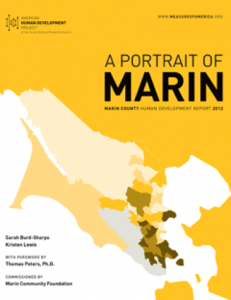A Portrait of Marin 2012
LAUNCHED JANUARY 2012
FULL REPORT [English] [Spanish] | MEDIA RELEASE| INTERACTIVE MAP
Commissioned by the Marin Community Foundation (MCF), A Portrait of Marin: Marin County Human Development Report 2012 was launched with a community conversation on January 18, 2012 in Marin, California. Donor and Advisory Panel

Read the Media Release
Explore Marin with Interactive Maps
The Way Forward
Download Data Set
A PORTRAIT OF MARIN: Marin County Human Development Report 2012
Some Marinites are enjoying extraordinarily high levels of well-being and access to opportunity, while others are experiencing levels of health, education, and standard of living that prevailed in the nation three decades ago. At the top of the rankings is Ross (HDI: 9.70), with the Canal area of San Rafael scoring the lowest (HDI: 3.18), below that of West Virginia, the lowest ranked state. Rankings are provided for the major racial and ethnic groups, men and women, and Marin’s fifty-one census tracts for which there are reliable U.S Census data.
SELECT FINDINGS:
Health:
- There is a 13-year gap in life span separating towns in Marin County. Residents of Ross have the longest lives (88 years), outliving residents of Hamilton in southern Novato (75.2 years) by 13 years.
- The average Ross resident lives nearly 8 years longer than the average Californian and an astonishing decade longer than the national average.
Education:
- While 88 percent of white children are enrolled in preschool, only 47 percent of Latino children are.
- While fewer than 30 percent of American adults have completed at least a four-year college degree, in Marin, over half have.
- In Marin, as across the nation, the schools whose students have greater needs tend to get fewer public dollars.
Income:
- The typical female worker living in Marin earns nearly $14,000 less per year than the typical male worker – a larger earnings gap than California ($10,217) and the overall national average ($11,179).
- Though Marin’s planners have targeted employment in areas such as biotechnology and software as a way to stimulate the recovery and the county’s long-term growth, the lion’s share of job growth that has occurred over the last two decades in Marin is overwhelmingly at the other end of the scale: low-wage service employment.
- The distribution of income in Marin is exceedingly lopsided; the top fifth of Marin taxpayers take home about 71 percent of the county’s total income. The bottom fifth earns 1.3 percent of the total income.
A Portrait of Marin highlights actions that Marinites can take to lock in human development successes today while setting the stage for significant budget savings and improved well-being tomorrow. These include creating an environment that reduces health risks; investing in preschool, and addressing the lower per-pupil spending in schools whose students have greatest needs; and expanding affordably priced housing to increase options for older adults and working families and to reduce Marin’s car congestion and pollution.
Visit our publications page for a complete list of national, state, county and thematic reports.
__________________________________________________________________________
For media and all other inquiries, contact us at: contact@measureofamerica.org | (718) 517-3720.